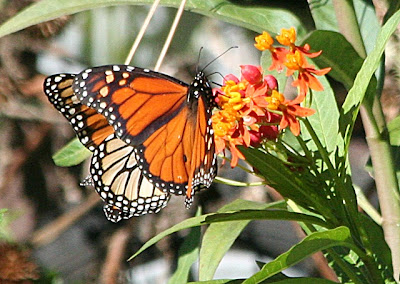Finally, there are visitors who are making good use of my lush stand of milkweed!
There were two of the butterflies present on this particular occasion, one male and one female. This one is the male. You can tell he's a male because he has those two small black dots, one on each of his hindwings on either side of his body.
This is the female. She is slightly larger with longer wings than the male.
Here are the two of them together sharing a milkweed blossom. The male is out front and the female slightly behind him.
The pair spent a good long period together among the milkweed, sipping nectar and resting with the wings outspread on the leaves. I hope that the female might have left me a present behind in the form of her eggs.
In addition to the milkweed, there are still plenty of other blossoms around to tempt the Monarchs and the other butterflies that are slowly showing up in the garden.
This purple trailing lantana is full of blossoms now and it is favored by various butterflies. I often see them visiting.
The blossoms of the abelia is favored more by the bees, but I do see butterflies stopping by the shrub occasionally.
The red-orange blossoms of the Cape honeysuckle attract the few hummingbirds that are still passing through, but butterflies stop to sip, too.
I've noticed that the 4 o'clocks seem to be a favorite of various skippers and of the sulphurs. Monarchs will stop by, as well.
Yes, it has been a down year for butterflies in general and that continues to be true, but their absence is not in any way related to a lack of host or nectaring plants. The cafeteria is well-stocked for any that find their way to my yard and the welcome mat is out.









I never knew how to tell the difference between the males and females. Now I'll have to look back at the photos I took a couple of weeks ago and see what I had visiting.
ReplyDeleteGreat butterfly shots. My favourite was the one with the pair sitting on the Milkweed blossoms. Hopefully you'll get to see some more lovely butterflies on those other blooming plants.
ReplyDeleteI always think it's fun to be able to know which sex is visiting, Jayne. With some butterflies, it is not always so easy to tell.
ReplyDeleteThank you, Bernie. We're seeing more swallowtails, sulphurs, and skippers now in addition to the Monarchs. Not as many as in a normal year, but the numbers are picking up.
ReplyDeleteOH Simply Spectacular!!! Hope you don't mind I shared your blog on our FB page!! You are welcome to do so anytime you like <3 So Let's Save the Monarchs!!!! =D WOw!!!
ReplyDeleteThanks, Pammy! I hope some of your FB friends will stop by.
ReplyDelete